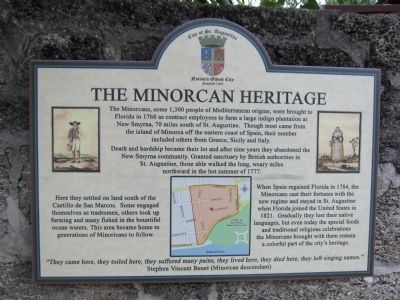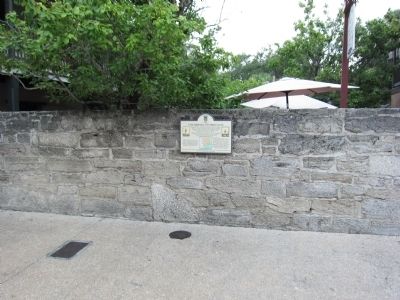St. Augustine in St. Johns County, Florida — The American South (South Atlantic)
The Minorcan Heritage
The Minorcans, some 1,300 people of Mediterranean origins, were brought to Florida in 1768 as contract employees to farm a large indigo plantation at New Smyrna, 70 miles south of St. Augustine. Though most came from the island of Minorca off the eastern coast of Spain, their number included others from Greece, Sicily and Italy.
Death and hardship became their lot and after nine years they abandoned the New Smyrna community. Granted sanctuary by British authorities in St. Augustine, those able walked the long, weary miles northward in the hot summer of 1777.
Here they settled on land south of the Castillo de San Marcos. Some engaged themselves as tradesmen, others took up farming and many fished in the bountiful ocean waters. This area became home to generations of Minoricans to follow.
When Spain regained Florida in 1784, the Minorcans cast their fortunes with the new regime and stayed in St. Augustine when Florida joined the United States in 1821. Gradually they lost their native languages, but even today the special foods and traditional religious celebrations the Minorcans brought with them remain a colorful part of the city's heritage.
"They came here, they toiled here, they suffered many pains, they lived here, they died here, they left singing names."
Steven Vincent Benet (Minorcan descendant)
Erected by City of St. Augustine.
Topics. This historical marker is listed in these topic lists: Colonial Era • Settlements & Settlers. A significant historical year for this entry is 1768.
Location. 29° 53.786′ N, 81° 18.798′ W. Marker is in St. Augustine, Florida, in St. Johns County. Marker is on St. George Street, on the right when traveling south. St. George Street is closed to vehicle traffic. Touch for map. Marker is in this post office area: Saint Augustine FL 32084, United States of America. Touch for directions.
Other nearby markers. At least 8 other markers are within walking distance of this marker. De Hita-González Houses (here, next to this marker); Salcedo House (here, next to this marker); Spanish Colonial Hygiene (a few steps from this marker); Arrivas House (a few steps from this marker); La Florida's El Camino Real (a few steps from this marker); Casa Avero (a few steps from this marker); British Colonial Hygiene (a few steps from this marker); Avero House (a few steps from this marker). Touch for a list and map of all markers in St. Augustine.
Also see . . .
1. The Minorcans in Florida. RootsWeb entry (Submitted on August 16, 2022, by Larry Gertner of New York, New York.)
2. Dr. Andrew Turnbull and the Origins of New Smyrna Beach. Florida Memory blog entry:
This article offers more detail of the Minorcan settlers' story, as well as photos showing food, crafts, and other elements of Minorcan traditions which have been passed down through generations of their descendants and remain alive in Florida today. (Submitted on May 16, 2014, by Glenn Sheffield of Tampa, Florida.)
Credits. This page was last revised on December 2, 2023. It was originally submitted on September 3, 2011, by Craig Swain of Leesburg, Virginia. This page has been viewed 1,733 times since then and 306 times this year. Last updated on April 13, 2014. Photos: 1, 2. submitted on September 3, 2011, by Craig Swain of Leesburg, Virginia. • Bill Pfingsten was the editor who published this page.

